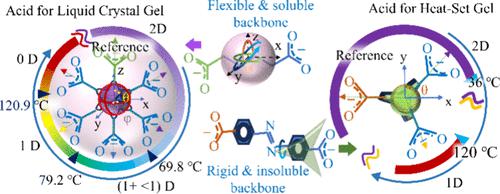当前位置:
X-MOL 学术
›
Cryst. Growth Des.
›
论文详情
Our official English website, www.x-mol.net, welcomes your feedback! (Note: you will need to create a separate account there.)
Introducing Dihedral Angle Torsion in a Flexible Dicarboxylic Acid: Evolution from a Sequential Symmetry Condensing Liquid Crystalline Gel to a Step-Halting Heat-Set Gel
Crystal Growth & Design ( IF 3.8 ) Pub Date : 2024-04-08 , DOI: 10.1021/acs.cgd.4c00160 Pathik Sahoo 1, 2
Crystal Growth & Design ( IF 3.8 ) Pub Date : 2024-04-08 , DOI: 10.1021/acs.cgd.4c00160 Pathik Sahoo 1, 2
Affiliation

|
Through systematic molecular engineering, versatile properties can be incrementally introduced into supramolecular materials. Nonetheless, even a minor internal modification in the molecular backbone can outperform the conventional molecular engineering approach to fine-tune its corresponding supramolecular properties. A dicarboxylate salt, categorically primary ammonium dicarboxylate (PAD) salt derived from a flexible dicarboxylic acid such as adipic acid, imparts conformational flexibility to the salt in gelling solvents. This results in the exhibition of sequential symmetry condensing the liquid crystal gel against rising temperatures. Gentle heating can unzip van der Waals interactions, showcasing a gradual 2D to 0D phase-changing ability and generating liquid crystalline properties. Such gradual symmetry reduction quantifies the entropy enhancement during heating. On the other hand, the manipulation of dihedral angle torsion within a dicarboxylic acid backbone offers a means to tailor solubility. By increasing the dihedral angle torsion, the molecule loses alignment against the solvent’s polarity or temperature, resulting in insolubility and conformational rigidity. Conversely, manipulating dihedral angle torsion within a dicarboxylic acid backbone provides a means to tailor solubility. Increasing dihedral angle torsion causes the molecule to lose alignment against the solvent’s polarity or temperature, resulting in insolubility and conformational rigidity. Incorporating higher dihedral angle torsion energy, such as introducing an azo or ferrocene backbone into a dicarboxylic acid, renders the resulting molecule resistant to solubilization, even at high temperatures, resulting in a heat-set gel. This transformation turns sequential symmetry-condensing liquid crystal gelator molecules into two-step halting polymorphic state-based heat-set gelator molecules. This review demonstrates that a conventional functional group is not always mandatory for introducing supramolecular properties. Instead, a physical parameter, such as dihedral angle torsion, can be generated to finely tune the thermostatic properties in developing supramolecular heat-set or liquid crystal gels.
中文翻译:

在柔性二羧酸中引入二面角扭转:从顺序对称冷凝液晶凝胶到逐步停止热定形凝胶的演变
通过系统的分子工程,可以将多种特性逐步引入超分子材料中。尽管如此,即使是分子主链的微小内部修饰也可以优于传统的分子工程方法来微调其相应的超分子特性。二羧酸盐,绝对是衍生自柔性二羧酸(例如己二酸)的二羧酸伯铵(PAD)盐,赋予盐在胶凝溶剂中的构象灵活性。这导致液晶凝胶在温度升高时表现出连续对称性。温和的加热可以解开范德华相互作用,展现出逐渐的 2D 到 0D 相变能力并产生液晶特性。这种逐渐的对称性降低量化了加热过程中的熵增强。另一方面,二羧酸主链内二面角扭转的操纵提供了一种调整溶解度的方法。通过增加二面角扭转,分子会失去针对溶剂极性或温度的排列,导致不溶性和构象刚性。相反,控制二羧酸主链内的二面角扭转提供了一种调整溶解度的方法。增加二面角扭转会导致分子失去针对溶剂极性或温度的排列,导致不溶性和构象刚性。引入更高的二面角扭转能,例如将偶氮或二茂铁主链引入二羧酸中,使得所得分子即使在高温下也能抵抗溶解,从而形成热定形凝胶。这种转变将顺序对称冷凝液晶胶凝剂分子转变为两步停止的基于多晶态的热定形胶凝剂分子。本综述表明,传统的官能团并不总是引入超分子特性所必需的。相反,可以生成物理参数,例如二面角扭转,以微调开发超分子热定形或液晶凝胶的恒温性能。
更新日期:2024-04-08
中文翻译:

在柔性二羧酸中引入二面角扭转:从顺序对称冷凝液晶凝胶到逐步停止热定形凝胶的演变
通过系统的分子工程,可以将多种特性逐步引入超分子材料中。尽管如此,即使是分子主链的微小内部修饰也可以优于传统的分子工程方法来微调其相应的超分子特性。二羧酸盐,绝对是衍生自柔性二羧酸(例如己二酸)的二羧酸伯铵(PAD)盐,赋予盐在胶凝溶剂中的构象灵活性。这导致液晶凝胶在温度升高时表现出连续对称性。温和的加热可以解开范德华相互作用,展现出逐渐的 2D 到 0D 相变能力并产生液晶特性。这种逐渐的对称性降低量化了加热过程中的熵增强。另一方面,二羧酸主链内二面角扭转的操纵提供了一种调整溶解度的方法。通过增加二面角扭转,分子会失去针对溶剂极性或温度的排列,导致不溶性和构象刚性。相反,控制二羧酸主链内的二面角扭转提供了一种调整溶解度的方法。增加二面角扭转会导致分子失去针对溶剂极性或温度的排列,导致不溶性和构象刚性。引入更高的二面角扭转能,例如将偶氮或二茂铁主链引入二羧酸中,使得所得分子即使在高温下也能抵抗溶解,从而形成热定形凝胶。这种转变将顺序对称冷凝液晶胶凝剂分子转变为两步停止的基于多晶态的热定形胶凝剂分子。本综述表明,传统的官能团并不总是引入超分子特性所必需的。相反,可以生成物理参数,例如二面角扭转,以微调开发超分子热定形或液晶凝胶的恒温性能。



























 京公网安备 11010802027423号
京公网安备 11010802027423号